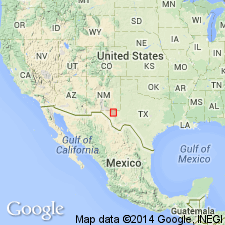
- Usage in publication:
-
- Bone Spring limestone
- Modifications:
-
- Original reference
- Dominant lithology:
-
- Limestone
- AAPG geologic province:
-
- Permian basin
Summary:
Pls. 10, 11. The basal dark limestone series in Guadalupe and Delaware Mountains is here designated Bone Springs limestone, although its correlatives elsewhere will continue to be called Leonard formation. The series will not here be included in Delaware Mountain formation, because of faunal difference, lithologic dissimilarities, and angular unconformity that separates the two. Upper part is gray limestone, lower part is black limestone. Cross bedding is noticeable at many points in both black and gray phases along Guadalupe scarp. North of Bone Springs Canyon a mass of hard, gray hackly limestone, which evidently has been removed at Bone Springs Canyon, comes into the series. It lies conformably on top of the black limestone. The gray and black phases seem to grade into each other from point to point. Total thickness exposed in Guadalupe Mountains 1,600+/- feet. From Guadalupe Point the Bone Springs limestone has been traced southward along western base of Delaware Mountains for approx. 25 miles. Correlated with Leonard formation of Glass Mountains, on similarity of fossils and lithology.
Named from Bone Springs Canyon, which opens in sec. 2, Blk. 66, northwest part of Culberson Co., TX.
Source: US geologic names lexicon (USGS Bull. 896, p. 233-234).

- Usage in publication:
-
- Bone Canyon member
- Modifications:
-
- Original reference
- AAPG geologic province:
-
- Permian basin
Summary:
Pg. 921-922, 924, 925. Treated this as basal member of [Leonard formation], and named it Bone Canyon member. [See entry under Delaware Mountain formation.]
[†Bone Canyon not adopted by subsequent workers. Bone Springs limestone (later Bone Spring) of Blanchard and Davis (1929) is the accepted name.]
[Misprint: US geologic names lexicon (USGS Bull. 896, p. 233, entry under Bone Spring limestone) states King and King treated their Bone Canyon as basal member of Delaware Mountain formation. King and King excluded their Bone Canyon from the Delaware Mountain formation, and treated it as a member of the Leonard formation.]
Source: US geologic names lexicon (USGS Bull. 896, p. 233-234, Delaware Mountain formation entry, p. 592).

- Usage in publication:
-
- Bone Springs member
- Bone Canyon member
- Modifications:
-
- Overview
- AAPG geologic province:
-
- Permian basin
Summary:
Pg. 157, 162, 181. Discussion of the stratigraphy in the Guadalupe, Delaware, and Apache Mountains, Diablo Plateau, and in subsurface of Permian basin. The Leonard formation in the Delaware and Guadalupe Mountains is represented by a dark limestone which has been named the Bone Springs member (Blanchard, Jr., and Davis, 1929, p. 962; and Crandall, 1929, p. 930), also called Bone Canyon member (King, 1930, p. 14). This limestone, referred to by Girty (1908, p. 10) as the basal black limestone, is about 1,000 feet thick and contains a fauna essentially identical with that of the Leonard of the Glass Mountains (King, 1930, p. 11). Among the species represented are PRODUCTUS LEONARDENSIS, MARGINIFERA CRISTOBALENSIS, PUGNOIDES TEXANUS, P. BIDENTATUS, COMPOSITA MEXICANA, and PERITOCHIA EREBUS, PARACELITES ELEGANS, AGATHICERAS TEXANUM, and PERRINITES sp. This limestone is exposed along the base of the escarpment of the Guadalupe and Delaware Mountains as far south as Seven Heart Gap. The type locality of this member is at Bone Springs Canyon on the west side of Guadalupe Mountain. On the west side of the Guadalupe Mountains a few miles north of Bone Springs Canyon the Bone Springs member is overlain by a white limestone which is there several hundred feet thick. Among the few fossils found in this limestone is AULOSTEGES MAGNICOSTATUS, a Leonard species. From its position in the section, its lithology, and limited fauna, this limestone is correlated by King (1930, p. 11) with the [Victorio] Peak member of the Leonard, the type locality of which is at [Victorio] Peak in the Diablo Mountains. At Bone Springs Canyon this member is absent, although a conglomerate at the base of the Delaware formation, according to King, contains boulders from it. At the east margin of the Diablo Plateau in the Sierra Diablo, the Bone Springs black limestone is 800 feet thick, and in part at least, grades laterally into the [Victorio] Peak white limestone. In tracing formations by means of well records it has been necessary to rely largely on lithologic characters since index fossils are even more rarely found than on the surface exposures. Eastward from the Guadalupe Mountains the Bone Springs member quickly drops in the Delaware basin below the depth of drilling.
References cited:
Blanchard, W.G., Jr., and Davis, M.J., 1929, AAPG Bull., v. 13, no. 8, pt. 2, p. 957-995. [see also I.A. Keyte and others, 1927, Jour. Paleo., v. 1, p. 175-178].
Crandall, K.H., 1929, AAPG Bull., v. 13, p. 927-944.
Girty, G.H., 1908, USGS Prof. Paper 58, p. 10. [see also revision by J.W. Beede, 1909, Jour. Geol., v. 17, p. 672-679].
King, R.E., 1930 [1931], Univ. Texas Bull., no. 3042, 245 p. [see also P.B. King and R.E. King, 1928, Univ. Texas Bull., no. 2801, p. 109-145; and P.B. King and R.E. King, 1929, AAPG Bull., v. 13, p. 907-926].
Source: Publication.

- Usage in publication:
-
- Bone Spring limestone*
- Modifications:
-
- Redefined
- AAPG geologic province:
-
- Permian basin
Summary:
Pg. 731, 755-768. Redefined Bone Springs limestone by including, at top, Victorio Peak massive member, and changed name to Bone Spring limestone, because there is only 1 spring present in Bone Canyon, although the place is locally called Bone Springs. This is present approved usage of USGS. He stated: The Bone Spring limestone was included by Richardson as a member in Delaware Mountain formation, but the unit has a greater extent and thickness than was originally supposed, and the faunas, as first pointed out by Girty, are not entirely like those of the beds above, so that it is now generally recognized as a distinct formation. Also: The definition of King and King applied only to the black limestones of the formation; in present paper the name is given the broader usage of Blanchard and Davis and applied to limestones of various sorts, of same general age and stratigraphic positions.
Source: US geologic names lexicon (USGS Bull. 896, p. 233-234).

- Usage in publication:
-
- Bone Spring limestone*
- Modifications:
-
- Overview
- AAPG geologic province:
-
- Permian basin
Summary:
These beds were included in Delaware Mountain Formation as originally defined and subsequently used, but they are now [ca. 1938] treated as a distinct formation, underlying (in places unconformably) Delaware Mountain formation and = Leonard formation. See also †Bone Canyon Member and W.B. Lang, 1937 (AAPG Bull., v. 21, no. 7).
Source: US geologic names lexicon (USGS Bull. 896, p. 234).

- Usage in publication:
-
- Bone Spring limestone*
- Modifications:
-
- Revised
- AAPG geologic province:
-
- Permian basin
Summary:
Pg. 566-575, pl. 2. Bone Spring limestone. Consists largely of limestones of varied types complexly interbedded and interfingered. Those laid down on shelf area outside Delaware basin, now exposed on Guadalupe Mountains and Sierra Diablo, are of different facies from those laid down within basin, now exposed in Delaware Mountains. Underlies Delaware Mountain group; overlies Hueco limestone and in some areas Wolfcamp series, undifferentiated. In Delaware Mountains, and as far north as Bone Canyon, exposed parts of formation are black cherty limestone in thin beds, with partings and a few members of shaly limestone and silic shale north of Bone Canyon; in Guadalupe Mountains, upper part of black limestone is replaced by thick-bedded gray limestone, Victorio Peak gray member, which forms capping stratum of Sierra Diablo. At top is Cutoff shaly member (new). Thickness several thousand feet. Age is Permian (Leonardian).
See also P.B. King, USGS Prof. Paper 215, p. 13-27, pls.
Source: US geologic names lexicon (USGS Bull. 1200, p. 424-425).

- Usage in publication:
-
- Bone Spring limestone
- Modifications:
-
- Areal extent
- AAPG geologic province:
-
- Permian basin
Summary:
Pg. 3 (table 1), 12-14, pl. 1. Bone Spring limestone. Victorio Peak and Cutoff members mapped in Otero County, New Mexico.
Source: US geologic names lexicon (USGS Bull. 1200, p. 424-425).
For more information, please contact Nancy Stamm, Geologic Names Committee Secretary.
Asterisk (*) indicates published by U.S. Geological Survey authors.
"No current usage" (†) implies that a name has been abandoned or has fallen into disuse. Former usage and, if known, replacement name given in parentheses ( ).
Slash (/) indicates name conflicts with nomenclatural guidelines (CSN, 1933; ACSN, 1961, 1970; NACSN, 1983, 2005, 2021). May be explained within brackets ([ ]).

